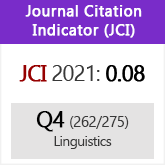What voice tells us about genetic syndromes: The case of Williams syndrome
DOI:
https://doi.org/10.3989/loquens.2017.039Keywords:
Williams syndrome, elastin deficit, voice, larynx biomechanics, vocal fold cover, tremorAbstract
The study of the voice is a very valuable tool in the field of rare diseases. That is because the biomechanical and acoustic analysis of phonation allows to detect specific features of a particular genetic and rare syndrome. In the case of Williams syndrome (WS), it was proved that some clinical features connected to this syndrome can be observed by means of voice analysis. In order to carry out this study, 60 recordings of 12 children suffering from WS were assessed and compared to 483 normative phonations of 97 children with typical development. The methodology used to assess the voices was BioMetroPhon (Gómez et al., 2013). The results may aim to establish a narrow connection between WS phonation and its typical genotype and, in consequence, the results of this study may highlight the interdisciplinary nature of the assessment of the voice.
Downloads
References
Antonell, A., Del Campo, M., Flores, R., Campuzano, V., y Pérez-Jurado, L. A. (2006). Síndrome de Williams: Aspectos clínicos y bases moleculares. Revista de Neurología, 42(1), 69-75.
Beuren, A. J., Apitz, J., y Harmjanz, D. (1962). Supravalvular aortic stenosis in association with mental retardation and a certain facial appearance. Circulation, 26(6),1235-1240. https://doi.org/10.1161/01.CIR.26.6.1235 PMid:13967885
Carmona-Duarte, C., Gómez-Vilda, P., Plamondon, R., Rodellar-Biarge, V., Palacio-Alonso, D., Ferrer-Ballester, M. A. y Alonso-Hernández, J. B. (2017). Phonatory and articulatory correlates in kinematic neuromotor degeneration. In Converging Clinical and Engineering Research on Neurorehabilitation II, 203-208. https://doi.org/10.1007/978-3-319-46669-9_36
Comisión Europea, Dirección General de Sanidad y Protección de los Consumidores (2008). Consulta Pública. Las enfermedades raras: Un Desafío para Europa. Disponible en http://ec.europa.eu/health/ph_threats/non_com/docs/raredis_comm_es.pdf
Ewart, A. K., Morris, C. A., Atkinson, D., Jin, W., Sternes, K., Spallone, P., … Keating, M. T. (1993). Hemizygosity at the elastin locus in a developmental disorder, Williams syndrome. Nature genetics, 5(1), 11-16. https://doi.org/10.1038/ng0993-11 PMid:7693128
Fant, G., Liljencrants, J., y Lin, Q. G. (1985). A four-parameter model of glottal flow. STL-QPSR, 4, 1-13.
Gray, S. D., Alipour, F., Titze, I. R., y Hammond, T. H. (2000). Biomechanical and histologic observations of vocal fold fibrous proteins. Annals of Otology, Rhinology & Laryngology, 109(1), 77-85. https://doi.org/10.1177/000348940010900115 PMid:10651418
Gómez-Vilda, P., Fernández-Baillo, R., Rodellar-Biarge, V., Lluis, V. N., Álvarez-Marquina, A., Mazaira-Fernández, L. M., … Godino-Llorente, J. I. (2009). Glottal source biometrical signature for voice pathology detection. Speech Communication, 51(9), 759-781. https://doi.org/10.1016/j.specom.2008.09.005
Gómez-Vilda, P., Rodellar-Biarge, V., Nieto-Lluis, V., Mu-oz-Mulas, C., Mazaira-Fernández, L. M., Ramírez-Calvo, C., … Toribio- Díaz, E. (2011). Neurological disease detection and monitoring from voice production. Advances in Nonlinear Speech Processing, 1-8. https://doi.org/10.1007/978-3-642-25020-0_1
Gómez, P., Rodellar, V., Nieto, V., Martínez, R., Álvarez, A., Scola, B., … Fernández, M. (2013). BioMet®Phon: A system to monitor phonation quality in the clinics. Proceedings of the 5th International Conference on e-Health, Telemedicine and Social Medicine, 253-258.
Lejeune, J., Gautier, M., y Turpin, R. (1959). Etude des chromosomes somatiques de neuf enfants mongoliens. Comptes Rendus des séances de l'Académie des Sciences, 248: 1721-1722.
Martin, N. D., Snodgrass, G. J., y Cohen, R. D. (1984). Idiopathic infantile hypercalcaemia-A continuing enigma. Archives of Disease in Childhood, 59(7), 605-613. https://doi.org/10.1136/adc.59.7.605 PMid:6465928 PMCid:PMC1628928
Moore, J., y Thibeault, S. (2012). Insights into the role of elastin in vocal fold health and disease. Journal of Voice, 26(3), 269-275. https://doi.org/10.1016/j.jvoice.2011.05.003 PMid:21708449 PMCid:PMC3190022
Mu-oz, C., Mazaira, L. M., Nieto, V., Rodellar, V., y Gómez, P. (2011). Voice quality analysis to detect neurological diseases. Models and Analysis of Vocal Emissions for Biomedical Applications, 79-82.
Roper, R. J., y Reeves, R. H. (2006). Comprender el fundamento de los fenotipos del síndrome de Down. Revista Síndrome de Down, 23, 59-67.
Strømme, P., Bjømstad, P. G., y Ramstad, K. (2002). Prevalence estimation of Williams syndrome. Journal of Child Neurology, 17(4), 269-271. https://doi.org/10.1177/088307380201700406 PMid:12088082
Thibeault, S. L., Gray, S. D., Bless, D. M., Chan, R. W., y Ford, C. N. (2002). Histologic and rheologic characterization of vocal fold scarring. Journal of Voice, 16(1), 96-104. https://doi.org/10.1016/S0892-1997(02)00078-4
Titze, I. (1994). Principles of voice production. Englewood Cliffs, NJ: Prentice Hall.
Urbán, Z., Riazi, S., Seidl, T. L., Katahira, J., Smoot, L. B., Chitayat, D., … Hinek, A. (2002). Connection between elastin haploinsufficiency and increased cell proliferation in patients with supravalvular aortic stenosis and Williams-Beuren syndrome. The American Journal of Human Genetics, 71(1), 30-44. https://doi.org/10.1086/341035 PMid:12016585 PMCid:PMC384991
Vaux, K. K., Wojtczak, H., Benirschke, K., y Jones, K. L. (2003). Vocal cord abnormalities in Williams syndrome: A further manifestation of elastin deficiency. American Journal of Medical Genetics Part A, 119(3), 302-304. https://doi.org/10.1002/ajmg.a.20169 PMid:12784297
Watts, C. R., Awan, S. N., y Marler, J. A. (2008). An investigation of voice quality in individuals with inherited elastin gene abnormalities. Clinical Linguistics & Phonetics, 22(3), 199-213. https://doi.org/10.1080/02699200701803361 PMid:18307085
Watts, C. R., Knutsen, R. H., Ciliberto, C., y Mecham, R. P. (2011). Evidence for heterozygous abnormalities of the elastin gene (ELN) affecting the quantity of vocal fold elastic fibers: a pilot study. Journal of Voice, 25(2), e85-e90. https://doi.org/10.1016/j.jvoice.2010.04.006 PMid:20926252 PMCid:PMC3765004
Whiteside, S. P. (2001). Sex-specific fundamental and formant frequency patterns in a cross-sectional study. The Journal of the Acoustical Society of America, 110(1), 464-478. https://doi.org/10.1121/1.1379087 PMid:11508971
Whiteside, S. P., Hanson, A., y Cowell, P. E. (2004). Hormones and temporal components of speech: Sex differences and effects of menstrual cyclicity on speech. Neuroscience Letters, 367(1), 44-47. https://doi.org/10.1016/j.neulet.2004.05.076 PMid:15308294
Williams, J. C. P., Barratt-Boyes, B. G., y Lowe, J. B. (1961). Supravalvular aortic stenosis. Circulation, 24(6), 1311-1318. https://doi.org/10.1161/01.CIR.24.6.1311 PMid:14007182
Published
How to Cite
Issue
Section
License
Copyright (c) 2017 Consejo Superior de Investigaciones Científicas (CSIC)

This work is licensed under a Creative Commons Attribution 4.0 International License.
© CSIC. Manuscripts published in both the printed and online versions of this Journal are the property of Consejo Superior de Investigaciones Científicas, and quoting this source is a requirement for any partial or full reproduction.All contents of this electronic edition, except where otherwise noted, are distributed under a “Creative Commons Attribution 4.0 International” (CC BY 4.0) License. You may read here the basic information and the legal text of the license. The indication of the CC BY 4.0 License must be expressly stated in this way when necessary.
Self-archiving in repositories, personal webpages or similar, of any version other than the published by the Editor, is not allowed.















